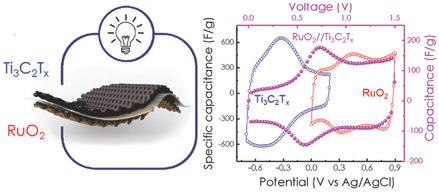当前位置:
X-MOL 学术
›
Adv. Energy Mater.
›
论文详情
Our official English website, www.x-mol.net, welcomes your
feedback! (Note: you will need to create a separate account there.)
All Pseudocapacitive MXene‐RuO2 Asymmetric Supercapacitors
Advanced Energy Materials ( IF 24.4 ) Pub Date : 2018-01-23 , DOI: 10.1002/aenm.201703043 Qiu Jiang 1 , Narendra Kurra 1, 2 , Mohamed Alhabeb 2 , Yury Gogotsi 2 , Husam N. Alshareef 1
Advanced Energy Materials ( IF 24.4 ) Pub Date : 2018-01-23 , DOI: 10.1002/aenm.201703043 Qiu Jiang 1 , Narendra Kurra 1, 2 , Mohamed Alhabeb 2 , Yury Gogotsi 2 , Husam N. Alshareef 1
Affiliation

|
2D transition metal carbides and nitrides, known as MXenes, are an emerging class of 2D materials with a wide spectrum of potential applications, in particular in electrochemical energy storage. The hydrophilicity of MXenes combined with their metallic conductivity and surface redox reactions is the key for high‐rate pseudocapacitive energy storage in MXene electrodes. However, symmetric MXene supercapacitors have a limited voltage window of around 0.6 V due to possible oxidation at high anodic potentials. In this study, the fact that titanium carbide MXene (Ti3C2Tx) can operate at negative potentials in acidic electrolyte is exploited, to design an all‐pseudocapacitive asymmetric device by combining it with a ruthenium oxide (RuO2) positive electrode. This asymmetric device operates at a voltage window of 1.5 V, which is about two times wider than the operating voltage window of symmetric MXene supercapacitors, and is the widest voltage window reported to date for MXene‐based supercapacitors. The complementary working potential windows of MXene and RuO2, along with proton‐induced pseudocapacitance, significantly enhance the device performance. As a result, the asymmetric devices can deliver an energy density of 37 µW h cm−2 at a power density of 40 mW cm−2, with 86% capacitance retention after 20 000 charge–discharge cycles. These results show that pseudocapacitive negative MXene electrodes can potentially replace carbon‐based materials in asymmetric electrochemical capacitors, leading to an increased energy density.
中文翻译:

所有伪电容MXene-RuO2不对称超级电容器
2D过渡金属碳化物和氮化物(称为MXenes)是一类新兴的2D材料,具有广泛的潜在应用范围,尤其是在电化学储能方面。MXene的亲水性及其金属电导率和表面氧化还原反应是MXene电极中高速率假电容储能的关键。但是,由于在高阳极电势下可能发生氧化,对称MXene超级电容器的电压窗口有限,约为0.6V。在这项研究中,利用碳化钛MXene(Ti 3 C 2 T x)可以在酸性电解液中在负电位下工作这一事实,通过将其与氧化钌(RuO 2)结合使用来设计全伪电容不对称器件。)正极。该非对称器件的工作电压窗口为1.5 V,约为对称MXene超级电容器的工作电压窗口的两倍,并且是迄今为止基于MXene的超级电容器所报道的最大电压窗口。MXene和RuO 2的互补工作电势窗口以及质子诱导的假电容可显着提高器件性能。结果,非对称器件可以以40 mW cm -2的功率密度提供37 µW h cm -2的能量密度。,在2万次充放电循环后具有86%的电容保持率。这些结果表明,伪电容性MXene负电极可以代替不对称电化学电容器中的碳基材料,从而提高能量密度。
更新日期:2018-01-23
中文翻译:

所有伪电容MXene-RuO2不对称超级电容器
2D过渡金属碳化物和氮化物(称为MXenes)是一类新兴的2D材料,具有广泛的潜在应用范围,尤其是在电化学储能方面。MXene的亲水性及其金属电导率和表面氧化还原反应是MXene电极中高速率假电容储能的关键。但是,由于在高阳极电势下可能发生氧化,对称MXene超级电容器的电压窗口有限,约为0.6V。在这项研究中,利用碳化钛MXene(Ti 3 C 2 T x)可以在酸性电解液中在负电位下工作这一事实,通过将其与氧化钌(RuO 2)结合使用来设计全伪电容不对称器件。)正极。该非对称器件的工作电压窗口为1.5 V,约为对称MXene超级电容器的工作电压窗口的两倍,并且是迄今为止基于MXene的超级电容器所报道的最大电压窗口。MXene和RuO 2的互补工作电势窗口以及质子诱导的假电容可显着提高器件性能。结果,非对称器件可以以40 mW cm -2的功率密度提供37 µW h cm -2的能量密度。,在2万次充放电循环后具有86%的电容保持率。这些结果表明,伪电容性MXene负电极可以代替不对称电化学电容器中的碳基材料,从而提高能量密度。


















































 京公网安备 11010802027423号
京公网安备 11010802027423号